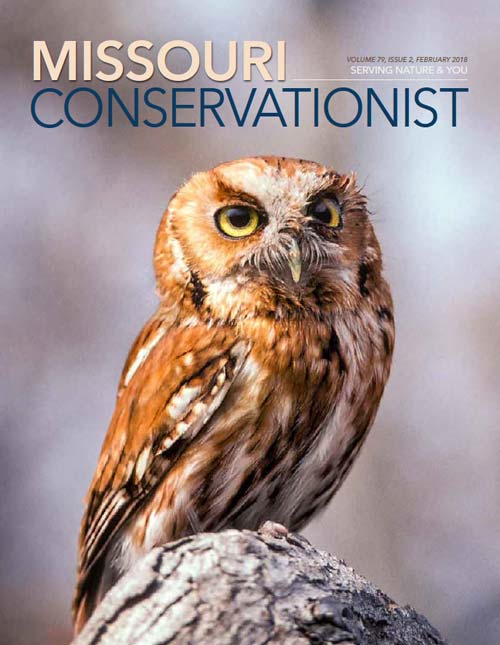I scanned my vegetable garden for one surviving green bean plant. Just two days ago, I had stood proudly admiring my handiwork after hoeing, raking, tilling, and planting. Most all of the seeds I had planted germinated and pushed from the fertile soil toward the sun. I thought to myself, this is going to be a bountiful year.
Now all I saw was a few stems poking out of the ground and very distinct tracks in the moist soil. I was certain a doe and her fawn had filled their bellies from my hard work. After looking closer at the stubble, I noticed another set of tracks aside from those of the deer. A rabbit had also enjoyed a free meal at my expense. With the exception of insects, few pests are as destructive to your garden as deer and rabbits. Whether they appear alone or in small herds, deer can wipe out entire vegetable gardens, flower gardens, and young trees and shrubs, and they can do it virtually overnight.
Yet even folks who are plagued by deer admit to a curious love/hate relationship with them. After all, they’re a beautiful, remarkable sight from your back deck. Rabbits won’t wreck your garden in a night, but they can decimate a row of newly sprouted green beans before you can say, “Cute, cuddly cottontail.” Rabbits are equally fun to watch from your back deck. Fortunately, what works for deer may work for rabbits, too.
Location, Location, Location
There are various ways of critterproofing your garden, including the best option: build a fence. But first you need to determine where to put your garden.
A healthy garden has three basic requirements: quality soil, no less than eight hours of continuous sunshine, and water for the dry days of summer.
In considering the location for your garden, you also need to be aware of game trails. As vegetarians, deer will frequent an area that has plenty of tasty greens to eat. Generally, plots of land that produce native flora are also ideal for your garden. However, if you choose to put in a garden along these heavily traveled areas, be prepared to install expensive fencing.
Good Fences Make Good Gardens
Many kinds of fencing materials will deter deer. Some examples are chicken wire, field fencing, welded-wire fencing, and electric-net fencing. Whatever fencing material you choose, you must think high or wide. An 8-foot-high fence will do the job. That will require specialized posts and fencing that can be very expensive. Deer can jump a 6-foot-high fence, but they are less likely to try if there are two rows of fencing — in other words, a fence within a fence. A simple 5-foot-tall chicken wire fence will suffice if you add an interior perimeter fence approximately 3 to 4 feet from the outer perimeter fence. I like using 16-foot by 4-foot-high cattle panels for the interior fencing because they also serve as trellises for tomato plants, cucumber and squash vines, and pole green beans.
Cattle panels don’t have to be continuous if they are spaced less than 7 feet apart around the interior perimeter. This requires planning when you’re considering what and where to plant within the garden. Structures like bean poles, raised beds, tomato cages, or trellises along the fence interior will cause the deer concern about a clean landing and possibly deter them from making the jump.
Rabbit-Proof Your Fence
If you have deer, you probably have rabbits, too. Your fence should have an apron of at least 10 inches of closely woven material bent out and away from the fence along the bottom. Chicken wire is your best option for keeping out smaller plant-eating critters like rabbits and turtles. It is a good idea to bury the wire apron to keep critters from digging under it. A 6-foot-tall roll of chicken wire will provide a 5-foot fence with a 12-inch apron.
Use Scents-ible Deterrents
You have chosen just the right spot. You put up a perimeter fence but the cost of an interior perimeter fence is a bit out of your budget. What else can you do? Certain plants have a scent or taste that deer do not like, and if you plant them along the perimeter they can act as a deterrent. Allium (onions), Baptisia (wild or false indigo), lavender, and Salvia (sage family) can work and will provide a colorful border when in bloom.
Another plant that most gardeners include in their plantings is asparagus, which is also considered a deer repellent.
Since it is perennial, gardeners usually plant it along the fence, out of the way of spring tilling. A good herb garden on the inside of the fence that includes garlic, sweet basil, rosemary, and oregano can act as repellent, too. As a disclaimer, I must say that in dry years when food is scarce, all bets are off on plants working as a repellent.
Some bar soap manufactures have inadvertently added scents to their product that deer do not like. Two specific brands are Ivory and Irish Spring (original scent). I like to grate the soap and put it in small bags. An old sock with a hole in the heel works great.
Who wants to darn socks anyway? Fill the toe section with your soap of choice and tie it to the fence. Place soap bags a few feet apart around the entire perimeter of the garden. I have heard that the scent of human hair works as well as soap bags at deterring deer. I haven’t tried this, but other gardeners swear by this tactic. Visit a local barber or beauty shop just before closing and ask if you can have the hair swept from the floor for that day. Bring your own sack and use rubber gloves when handling the hair. Spread it liberally around the outer perimeter of your fence. You can also place some of the hair in the same sock bags as your soap. You will need to follow up with subsequent application of hair during the growing season because it will lose its scent after a few weeks.
Other scents deer dislike are coyote urine and rotten eggs. Gardeners with a poor sense of smell can buy these commercially produced scents at sporting goods stores or online. Some products might not be eco-friendly, so be sure to check the labels before purchasing. Again, in dry years or where food is scarce, such as urban areas, scent deterrents may have little to no effect.
Try Scare Tactics
Deer don’t like sudden sounds or rapid movements. This makes them vulnerable to homemade or commercial scare tactics. For an easy homemade noise maker, tie a lightweight aluminum pie plate directly to the fencing with a footlong twine. A slight breeze will move the plate, causing it to bump continuously against the fence. The flash of the aluminum also creates highly visible movement. Used CDs work as well. I prefer the pie plates because their increased surface area catches more wind and they make a loud clacking sound when they strike the fence.
Commercially available scare tactics offer motion-detection triggering and emit loud, high-frequency sounds. These work better than continuous sounds.
Deer will adapt to and ignore continuous sounds if no threat is perceived. It is recommended you change strategies often. Another commercial scare tactic is the motion-activated sprinkler. It shoots a fast stream of water that will make a deer think twice about invading your tomatoes.
Wildlife are only afraid of something while it’s new. If they determine a tactic has no effect on them, whether it’s the scent of a predator, a flash of light, or a blast of sound or water, they will continue to do as they please. For this reason, a good outdoor dog is one of the best scare tactics I know of.
Success at Last!
After replanting my green beans a third time and building a sturdy fence, I used the soap-in-a-sock method as an additional perimeter defense tactic. I also hung aluminum pie plates on my fence. The deer and rabbits were kept at bay, and I had a successful planting and harvest from the garden this year.
Here’s one last tip. If you can’t afford to build a sturdy, permanent fence and all your other efforts to curtail the problem have failed, consider these two options. Next year, move your garden away from deer trails. Then put up a deer stand over your abandoned garden.
In November, fill your slow cooker with some potatoes, onions, carrots, and herbs from your new garden — along with a nice venison roast. This will make for a very satisfying fall feast.
Who Bit the Bean Plant?
Here are some clues: Rabbits have both a lower set of teeth and very sharp upper incisors. When they bite a young plant, the cut is clean. Deer have teeth on the lower jaw but only a hard palate on their upper jaw. Instead of a clean cut, the bite will be jagged or torn. The bean plant on Page 23 shows a clean cut, so a rabbit is the culprit in this case.
Online Tips for Controlling Nuisance Wildlife
Learn how to control 25 kinds of wildlife that can become a problem in Missouri, and explore ways to prevent wildlife from becoming a nuisance at short.mdc.mo.gov/Z5L.
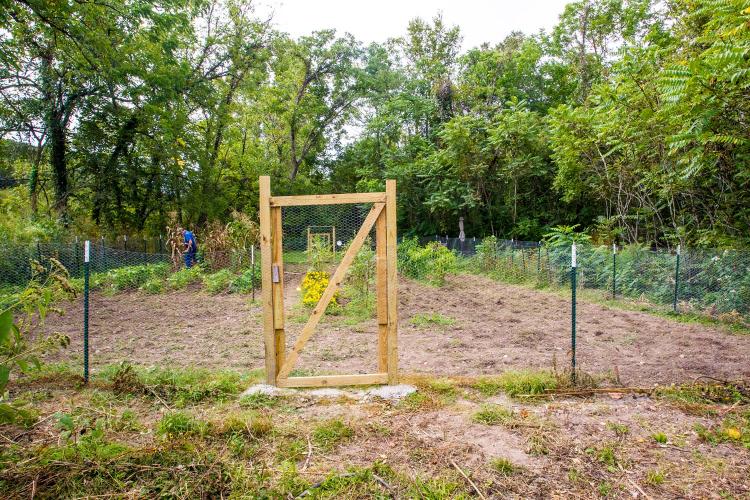

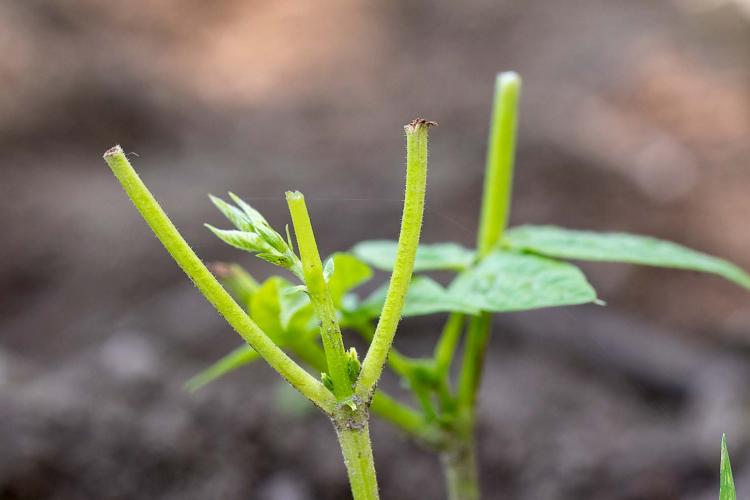




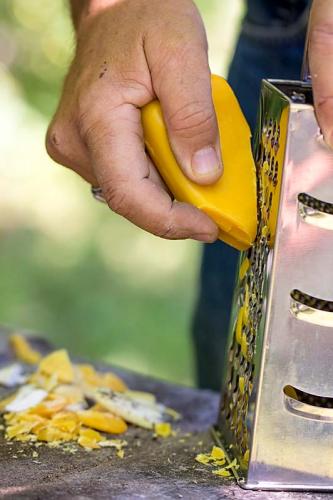








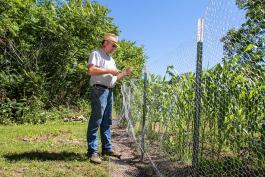


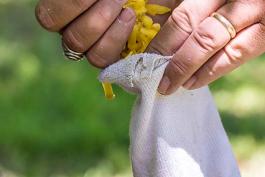


Also In This Issue


And More...
This Issue's Staff
Associate Editor - Bonnie Chasteen
Staff Writer - Larry Archer
Staff Writer - Heather Feeler
Staff Writer - Kristie Hilgedick
Staff Writer - Joe Jerek
Creative Director - Stephanie Thurber
Art Director - Cliff White
Designer - Les Fortenberry
Designer - Marci Porter
Photographer - Noppadol Paothong
Photographer - David Stonner
Circulation - Laura Scheuler






















